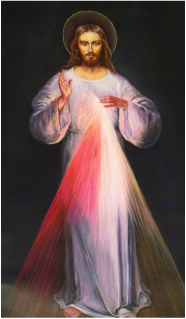Learn about the Image of Divine Mercy in the Video Below
Veneration of the Image of "The Divine Mercy"

In Poland on February 22, 1931 Jesus appeared to St. Faustina dressed in a white garment as the Risen Christ with the scars of the crucifixion on His hands, feet, and side. He appeared in this way because it is in the Passion, Death and Resurrection of Christ that we have the fullness of Divine Mercy revealed to us. For this reason this image is called: “The Divine Mercy.” In the Divine Mercy Image everything has a spiritual meaning. Jesus is opening His robe with his left hand, but we do not see His heart. We see that from His pierced side two beautiful rays of light issue forth: a pale and a red ray. He is reminding us of the treasures that He has given us in the Catholic Church through the Sacraments.
He says, “The pale ray stands for the Water which makes souls righteous. The red ray stands for the Blood which is the life of souls. These two rays issued forth from the very depths of my tender mercy when My agonized Heart was opened by a lance on the Cross. Blessed is the one who will dwell in their shelter, for the just Hand of God will not lay hold of him.” (Diary, 299) Jesus told St. Faustina, “Paint an image according to the pattern you see, with the words, ‘Jesus, I trust in You.’ I desire that this image be venerated first in your chapel, and [then] throughout the world." (Diary- Divine Mercy in My Soul, 47)
Jesus is in a walking position. He is searching for the sinner just like the Father of the Prodigal Son was eagerly awaiting His son's return. (Luke 15:20) He says, “With My mercy, I pursue sinners along all their paths... I am always waiting for them... I listen intently to the beating of their heart... when will it beat for Me? ... I am speaking to them through their remorse of conscience, through their failures and sufferings, through thunderstorms, through the voice of the Church." (Diary, 1728) "I tell you, in just the same way there will be more joy in heaven over one sinner who repents than over ninety-nine righteous people who have no need of repentance." (Luke 15:7)
Jesus attached graces to the veneration of the Image of the Divine Mercy. He said, “I am offering people a vessel with which they are to keep coming for graces to the fountain of mercy. That vessel is this image with the signature: ~Jesus, I trust in You~.” (Diary, 327) “By means of this image I shall be granting many graces to souls; so let every soul have access to it.” (Diary, 570)
You know if you approach a fountain and you want to draw water, you have to have a container to draw the water with. Jesus explains, “Tell souls that from this fount of mercy souls draw graces solely with the vessel of trust.” (Diary, 1602) This is why the words beneath the Image of the Divine Mercy say, “Jesus I trust in You.”
Jesus has His hand raised giving a blessing. Jesus has died for us. He has shed his very last drop of blood for us. Now we must do the same in service to our neighbor. Jesus tells St. Faustina, "It is to be a reminder of the demands of My mercy, because even the strongest faith is of no avail without works.” (Diary, 742) He says, "I demand from you deeds of mercy, which are to arise out of love for Me. You are to show mercy to your neighbors always and everywhere." (Diary, 742) We are to be people of mercy always and everywhere by the deeds we do, by the words we say, and by our prayers. Everything about us is to reflect His goodness, because on the Day of Judgment we will be judged according to the good works we show now.
The Catholic Church teaches us seven works of mercy pertaining to the body and seven pertaining to the soul. We call them the corporal and spiritual works of mercy. The corporal works of mercy are to: feed the hungry, give drink to the thirsty, clothe the naked, shelter the homeless, visit those in prison (ransom the captive), comfort the sick, and bury the dead. The spiritual works of mercy are to: admonish sinners, instruct the uninformed, counsel the doubtful, comfort the sorrowful, bear wrongs patiently, forgive offenses, pray for the living and the dead.
He says, “The pale ray stands for the Water which makes souls righteous. The red ray stands for the Blood which is the life of souls. These two rays issued forth from the very depths of my tender mercy when My agonized Heart was opened by a lance on the Cross. Blessed is the one who will dwell in their shelter, for the just Hand of God will not lay hold of him.” (Diary, 299) Jesus told St. Faustina, “Paint an image according to the pattern you see, with the words, ‘Jesus, I trust in You.’ I desire that this image be venerated first in your chapel, and [then] throughout the world." (Diary- Divine Mercy in My Soul, 47)
Jesus is in a walking position. He is searching for the sinner just like the Father of the Prodigal Son was eagerly awaiting His son's return. (Luke 15:20) He says, “With My mercy, I pursue sinners along all their paths... I am always waiting for them... I listen intently to the beating of their heart... when will it beat for Me? ... I am speaking to them through their remorse of conscience, through their failures and sufferings, through thunderstorms, through the voice of the Church." (Diary, 1728) "I tell you, in just the same way there will be more joy in heaven over one sinner who repents than over ninety-nine righteous people who have no need of repentance." (Luke 15:7)
Jesus attached graces to the veneration of the Image of the Divine Mercy. He said, “I am offering people a vessel with which they are to keep coming for graces to the fountain of mercy. That vessel is this image with the signature: ~Jesus, I trust in You~.” (Diary, 327) “By means of this image I shall be granting many graces to souls; so let every soul have access to it.” (Diary, 570)
You know if you approach a fountain and you want to draw water, you have to have a container to draw the water with. Jesus explains, “Tell souls that from this fount of mercy souls draw graces solely with the vessel of trust.” (Diary, 1602) This is why the words beneath the Image of the Divine Mercy say, “Jesus I trust in You.”
Jesus has His hand raised giving a blessing. Jesus has died for us. He has shed his very last drop of blood for us. Now we must do the same in service to our neighbor. Jesus tells St. Faustina, "It is to be a reminder of the demands of My mercy, because even the strongest faith is of no avail without works.” (Diary, 742) He says, "I demand from you deeds of mercy, which are to arise out of love for Me. You are to show mercy to your neighbors always and everywhere." (Diary, 742) We are to be people of mercy always and everywhere by the deeds we do, by the words we say, and by our prayers. Everything about us is to reflect His goodness, because on the Day of Judgment we will be judged according to the good works we show now.
The Catholic Church teaches us seven works of mercy pertaining to the body and seven pertaining to the soul. We call them the corporal and spiritual works of mercy. The corporal works of mercy are to: feed the hungry, give drink to the thirsty, clothe the naked, shelter the homeless, visit those in prison (ransom the captive), comfort the sick, and bury the dead. The spiritual works of mercy are to: admonish sinners, instruct the uninformed, counsel the doubtful, comfort the sorrowful, bear wrongs patiently, forgive offenses, pray for the living and the dead.


